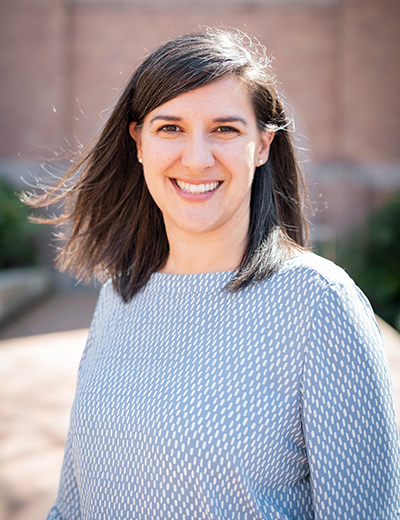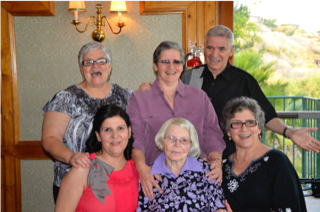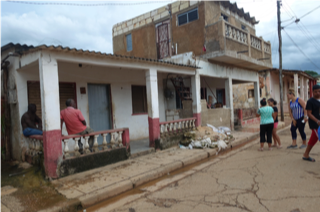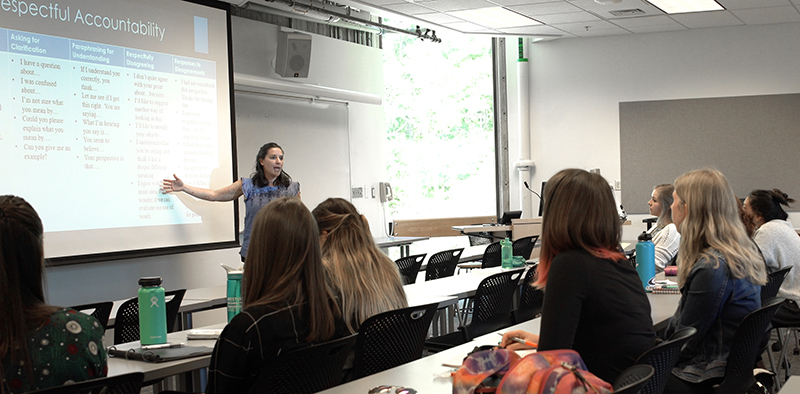Portfolio

Using Free Podcasts to Engage Students in Multicultural Discussions
Jessica Ferreras-Stone
Department of Elementary Education
What I Do
I am a passionate educator of multicultural studies in elementary education. Many have asked how I engage students in discussion of equity, social justice, and diversity given the sensitivity of the topic. My response is multifaceted:
- I do not believe there is a “right” way to do this, but rather a way that best suits the particular needs of our students
- I’m always seeking new ways to do this
- At the moment, I’m doing this through podcasts

School and learning are, unfortunately, not synonymous with one another. Too often, frustrated students ask themselves how any of the content learned in school is useful in their lives. This problem exists because schools have often taught students how to be successful on a test instead of how that knowledge can help them be successful on a test and in life. Linda Darling Hammond describes this well, stating, “If we taught babies to talk as most skills are taught in school, they would memorize lists of sounds in a predetermined order and practice them alone in a closet.” Mindful of this problem, I actively seek ways to engage students in dialogue that makes connections to their personal lives and future careers. Making such connections is important in all areas and is particularly important when discussing and learning about culturally-relevant instruction.
I actively seek ways to engage students in dialogue that makes connections to their personal lives and future careers. Making such connections is important in all areas and is particularly important when discussing and learning about culturally-relevant instruction.
The importance of multicultural education cannot be understated. In brief, student demographics in U.S. schools are becoming more diverse, yet these students continue to be predominantly taught in elementary school by white, straight, cisgender female teachers that use a Eurocentric curriculum. Therefore, as an instructor of elementary education I must find ways to not only engage my students in discussion of equity and diversity, but I must also require my students to envision the ways in which these ideas can and will shape their own teaching. In other words, I must guide them in the application of knowledge to ensure a better future.
Although there are MANY outstanding articles theorizing, problematizing, and conceptualizing equitable teaching practices, most are locked behind paid firewalls vastly limiting their use. Because application of multicultural knowledge is so important, I sought course readings that were created for the general public thus ensuring that my students could engage in this practice well beyond their university careers. This, alone, is what led me to use podcasts as “course readings.”
Because application of multicultural knowledge is so important, I sought course readings that were created for the general public thus ensuring that my students could engage in this practice well beyond their university careers. This, alone, is what led me to use podcasts as “course readings.”
Why It’s Important
Why I teach multicultural education
When my second-grade teacher asked me to draw my family, I drew not only my mother and sister, but also my mima (grandmother) primos, primas, tias, and tios. Surprised at how many stick figures were on the page, my teacher asked me to draw my nuclear family. The puzzled look on my face revealed my confusion, so she explained this term to mean the family members that lived with me. Because I lived in a multigenerational and multifamily home my paper still had “too many people.”

I remember feeling as though I had gotten the answer wrong. I wish I could go back in time to defend myself and explain that each person determines the correct answer to this question and therefore there is no “wrong answer.” I’m not suggesting that my second-grade teacher did this on purpose, nevertheless, her words were hurtful and culturally insensitive.
Too many students encounter similar instances where they feel marginalized by the school system. It is for this reason that I feel a deep need to facilitate the creation of culturally competent teachers who are not done learning how to think equitably at the end of their coursework, but rather are ready and willing to engage in deep reflection regarding social justice throughout their careers.

Why I teach with podcasts
I do not believe in lecturing to my students, instead I prioritize engaging in deep conversation with my students. This, of course, requires that my students be active participants. Yet, I found it particularly challenging for students to engage in discussions regarding topics of historically marginalized groups. This presented a problem given not only the importance of the topic, but this also stood at odds with my teaching philosophy of education that is deeply rooted in the application of knowledge. After all, how could I expect students to apply knowledge that they were not even comfortable discussing?
I found it particularly challenging for students to engage in discussions regarding topics of historically marginalized groups.
Although the problem was easy to identify, the solution was not nearly as easy to solve. While brainstorming multiple solution ideas, I identified a subset of the problem to be that students did not have a safe space to hear scaffolded dialogue regarding multicultural content. Instead, students were reading in solitude and expected to discuss in public. This then inspired me to find ways to scaffold diversity dialogue, which I found in podcasts.
While brainstorming multiple solution ideas, I identified a subset of the problem to be that students did not have a safe space to hear scaffolded dialogue regarding multicultural content. Instead, students were reading in solitude and expected to discuss in public. This then inspired me to find ways to scaffold diversity dialogue, which I found in podcasts.
Upon further reflection, I identified the following additional advantages when podcasts replaced the traditional readings of scholarly journals:
- Cost savings, which allowed students to
- Readily share podcasts with peers not enrolled in the course, thus
- Providing opportunities for authentic conversations; additionally,
- Students saw podcasts as a time saving mechanism that
- Facilitated multiple learning modalities.
Most importantly, I chose to implement podcasts so that students could listen in on a conversation regarding race, gender, and class differences (to name a few) as a means to envision how they themselves might participate in similar dialogue. They could do this, not only in the university setting, but also to envision how such dialogues might take place in age appropriate ways in their own classrooms once they became teachers. Upon implementing podcasts, I noted that the often awkward and somewhat silent five minutes before class sessions were now filled with student discussion regarding podcast content. This student-led conversation was a welcomed change to the hesitant dialogue that was previously taking place in class.
Upon implementing podcasts, I noted that the often awkward and somewhat silent five minutes before class sessions were now filled with student discussion regarding podcast content.
As I listened in on student dialogues, I discovered how pleased students were to not have to pay for an expensive and often outdated textbook which they would have to haul around campus. Given that podcasts were free and readily available on the internet, students mentioned listening to them with peers (not enrolled in the class) and sometimes sharing the link with peers they thought would enjoy the content. Some students even sent the link to their parents and had follow up conversations. The conversations students had with unenrolled peers/parents provided students with additional scaffolding and prepared students for enriched classroom discussion. Additionally, talking about course content outside of the class allowed students to really see the value and application of the content. Thus, increasing the likelihood of engaging in this practice after the conclusion of the course. In fact, one student summarized this, stating, “it feels less like school, ‘cause we aren’t reading textbooks that were made for school. It’s like using stuff that was made for real people.”

Students also welcomed podcasts in place of readings because they could multitask while listening to a podcast. For example, some students listened to podcasts while commuting to campus, others walked on the treadmill, and yet others engaged in house chores. This multitasking allowed students to move while “reading” thus helping them retain the information while also helping them save time.
Lastly, listening to content instead of engaging in traditional readings demonstrated the ways in which culturally-relevant teachers present learning in multiple modalities so that all students can learn.
Stated succinctly, I teach with podcasts because they are not locked behind firewalls and thus present an authentic learning format that is sustainable once students have left the university setting.
I teach with podcasts because they are not locked behind firewalls and thus present an authentic learning format that is sustainable once students have left the university setting.
How To Do It
Where do you find podcasts? This is a question I have frequently been asked, and the truth is I’ve spent MANY hours searching for podcasts. Those wishing to use podcasts for multicultural topics may find my list of podcasts helpful (see Podcast Selections).
Because students are accustomed to taking notes or possibly highlighting when preparing for a class, I found that they are not sure how to come to class prepared for discussion after having listened to a podcast. For this reason, I have created a reading analysis guide for them to complete and bring to class. Although they do not submit this analysis guide for points, I find that it helps them think about the podcast and how they personally can contribute to the classroom conversation given their own interpretation of the podcast. See Reading Analysis Guide worksheet.
The reading analysis guide asks students to:
- Identify and summarize three to five ideas that stand out to you as important.
- Develop two or three critical questions to stimulate analysis about the content and its connections to teaching.
- Identify an idea conveyed in the podcast that you either did not agree with or only partially agree with.
- Identify ideas to investigate further and a relevant resource.
- Explain how/why what you learned from this podcast are important for teachers.

Each of these prompts serve a purpose and guide our discussion in class. The first ensures that students have a brief summary of the readings that they can refer to when discussing the topics. One drawback to listening to podcasts as opposed to traditional readings is that students do not have an article that they can skim and bring to class to refer to when providing responses. Yet, identifying and summarizing three to five topics prompts the students to recall the information and write something down that they can then reference. An interesting extension I’ve done in conjunction with this reading analysis guide is to have students compare how their important ideas and summaries align with a classmate’s work. Then explore why they selected particular topics that their peers did not.
The second question asks students to identify an idea conveyed in the podcast that they either did not agree with or only partially agreed with. I do this because a major barrier to engaging in diversity discourse is the fear of disagreement. While I’ll admit that this can lead to some strong opinions conveyed in class, I would recommend such a question because it requires students to think critically and not just take all information as truth. Additionally, the discussion that takes place in class as a result of this question scaffolds students not to seek agreement but, rather, understanding each other’s ideas. In other words, it scaffolds their understanding of multiple perspectives, a needed practice for culturally competent instruction.
Too often schools are a place where it is the teacher’s job to ask questions and it is the student’s job to answer questions. Yet, students need to learn how to ask good questions if they are to actively engage in the content throughout their careers. Moreover, my students are about to become teachers and thus need to sharpen their questioning skills. I have found that asking students to bring questions to class prepares them to come ready to learn something that can be meaningful and applicable for them.
Too often schools are a place where it is the teacher’s job to ask questions and it is the student’s job to answer questions. Yet, students need to learn how to ask good questions if they are to actively engage in the content throughout their careers.
Lastly, students are asked to seek connections from the podcast to their future careers. This for me speaks to the application of knowledge discussed earlier. Admittedly, I don’t call this the application of knowledge when I’m teaching; instead, I call it the “so what factor.” As such, I can often be heard asking students, “So what?” and, “What more?” Doing so creates a bridge from theory to practice that invites students to take their learning beyond the confines of the university classroom. It requires students to envision their future career and apply their knowledge to those settings. See What More Activity.
In preparation for each class period I also listen to each podcast (multiple times), take notes on the podcast, and create PowerPoints that present supplemental information. Additionally, I highlight the questions students create for class and also I create my own thought-provoking questions and insert them as needed into the class discussion. See Lesson Plan Example.
In preparation for each class period I also listen to each podcast (multiple times), take notes on the podcast, and create PowerPoints that present supplemental information. Additionally, I highlight the questions students create for class and also I create my own thought-provoking questions and insert them as needed into the class discussion.

Next Steps
At the moment, my students are benefitting greatly from the podcasts by listening to them, investigating the topics, and engaging in deep reflection—both on their own and in class (see Student Comments). Great conversation happens in our classroom. This is reflected in the students’ coursework, yet their ideas are limited to the audience of their classmates. It seems that a natural next step would be for students to share their ideas with a broader audience by creating their own podcasts on related topics and posting them for a greater audience.
References
Darling-Hammond, L. (2016). Be the Change: Reinventing School for Student Success, p.114, Teachers College Press.
National Center for Education Statistics (2019). Available: https://nces.ed.gov/
